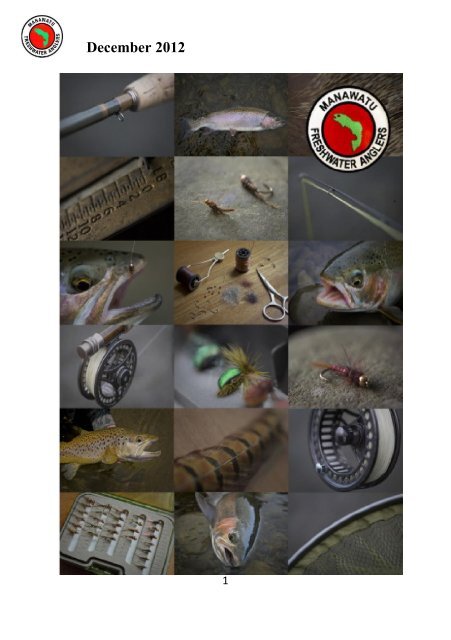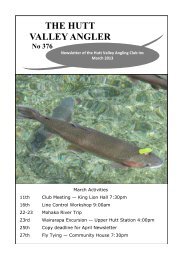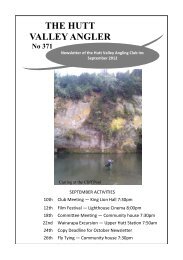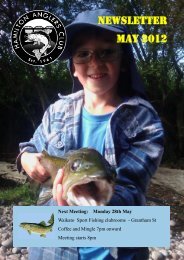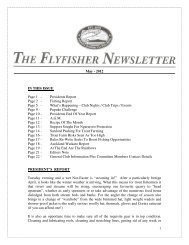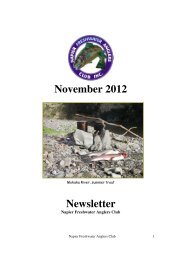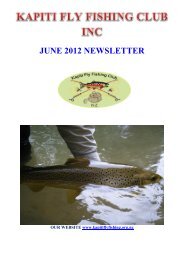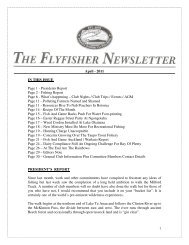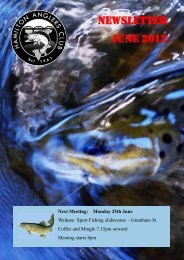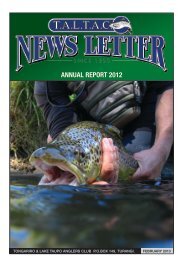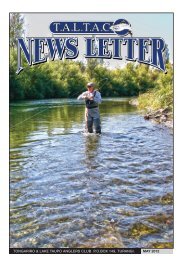Manawatu Anglers December 2012 Newsletter - Christchurch ...
Manawatu Anglers December 2012 Newsletter - Christchurch ...
Manawatu Anglers December 2012 Newsletter - Christchurch ...
You also want an ePaper? Increase the reach of your titles
YUMPU automatically turns print PDFs into web optimized ePapers that Google loves.
<strong>December</strong> <strong>2012</strong>1
<strong>December</strong> <strong>2012</strong>From the President.Can you believe it? It is <strong>December</strong> again, theend of yet another year. Don’t know aboutyou but for me this is by far the best time ofthe year; a time of unbridled indulgence andjoy.May I take this opportunity of wishing youand your family a wonderful Christmas andthe very best New Year.At this time of giving please give a thoughtto paying you Club fees. I really don’t want to publish a list of thosewho have not paid.Thanks to one and all who helped with the Children’s Fishing Day, allwent well and according to plan save for the non-cooperative fish onthe Saturday afternoon sponsors day. We have since changed thearrival time of the fish for next year to give them time to settle down.Saturday 8 th <strong>December</strong> we are having another day at DuddingsLake, start at about 10.00am. Bring your kids, other fishermen,boat etc. We will give the new BBQ a test run for lunch; the Clubwill supply the sausages and bread, if you want anything better,BYO.Next Club night will also be another BBQ, the Club will supplythe sausages, bread and steak; if you want a salad or dessert or awine or beer BYO. We will also hold the casting competitions atthat time so come along and have some fun. Bring along your bestcooked, bottled, smoked etc trout and be in to win a bottle of wineFirst Club night, third Thursday in February guest speaker will beSteve Pilkington, speaking on his recent drift dives and the state of ourlocal rivers.2
<strong>December</strong> <strong>2012</strong>Once again, thanks so much for your help with the CFD. The speedthat the whole site was cleared and gear stacked away in Larry’s shedwas truly impressive.Stay safe and enjoy your break if you are lucky enough to be haveone, catch lots of fish and just enjoy.And please; take lots of photos as the Club Calendar will have to beput together in February. Also think about where you would like to goas a change on Club trips next year.Take Care and Best wishes to you all.Stewart JewellNext Committee Meeting;Thursday 20 th <strong>December</strong> 6pm Club RoomsNext Club Night:Thursday 20 th <strong>December</strong> 7.30pm Club RoomsFly Tying:Wednesday 5 th <strong>December</strong> (final fly tying for <strong>2012</strong>Club Trips:<strong>2012</strong> <strong>December</strong> 7-9 Springvale2013 January 18 – 20 Lake OtamangakauFebruary 22-24 Whanganui RiverMarch 3 rd Founders DayMarch 22 – 24 Mokau RiverIt is important to contact John Beattie 06 368 1518 orjosu@paradise.net.nz with your intentions 14 days prior soaccommodation can be arranged in plenty of time.Guest SpeakerSteve Pilkington Wellington Fish and Game region field officerspeaking on how fish population and condition are measured by driftdiving river and health of the river and the aquatic life.3
<strong>December</strong> <strong>2012</strong>Web Sites of InterestThe Advocates for Tongarirowww.tongariroriver.org.nzRecreational access to our lakes, beaches, rivers and mountainshttp://www.walkingaccess.govt.nz/NZ Federation Freshwater <strong>Anglers</strong>www.nzfishingclubs.co.nz/index.htmFish & Game NZwww.fishandgame.org.nzFly Fishers Incwww.flyfishersinc.comTurangi RevisitedFive or six years have passed since Ron and I fished the Tongariro.The problem is that I now go to Australia during the winter at whatwas the peak fishing time. However we were told that the runs aregetting later so we thought that the end of October should be OK. Wetraditionally stayed at the Sportsmans Lodge and got advice fromRoyden Thorburn (a retired guide) who built it and initially ran it.We phoned him to ask about the fishing and discovered that he had aflat under his house in Taupahi road and we would be welcome to staythere. He sometimes allows other anglers to stay there too. Thisaccommodation served us well and had the advantage of being able toget Royden’s advice occasionally.We found that the river has changed greatly from our last trip so weneeded advice to avoid wasting time. Starting on the morning of 20Oct. Royden (on his day-off) showed us the very convenient pool onthe town side a few 100metres past the RSA. Ron got one there and Ilost one, but the pool gets a lot of fishing pressure and we had limitedluck there later. Royden in his 4X4 then drove us far down the trueleft bank to what was called Shaw’s reach but is now called the Asianpool since it is the top choice of guides escorting Asian tourists. Wenymphed but did not get a touch. At that point I met Gerry Campbell4
<strong>December</strong> <strong>2012</strong>and his wife Diane. Gerry helped me to set up Massey courses yearsago, so I am in his debt, and we are old friends. He lives in Wellingtonbut rents a house in Turangi and spends half his time there fishing. Hetold me to change to a sinking line, gave me several rabbit flies andescorted me to a spot at the top of the pool where with his help Imanaged to withstand the current and eventually got a good fish. Iimmediately frog-marched Ron to the spot in the hope that he wouldget one also; He didn’t, but next day we got three excellent fish there.In hindsight we would have done better to spend more time at thatpool and the one below but we wanted to explore as much of the riveras possible. Boulder reach was one of the best for us. To reach it youtake the track to the Blue Pool but take the first turning off to the left .You come to a fork: on the left is the Poutu pool and the right bringsyou to the Boulder. I nymphed, hooked and lost fish in the Poutu andalso nymphed the Boulder but changed to a wetline and got what forme was the best fish from the river- a four pound Jack.In previous years we went to the mouth of the TT in the evening andagainst advice we went this year too, but the mouth has changed andwe did not know how to fish it. The lake was too high to fish themouth of the Waimarino so the lake was no good for us.Overall we got an average of one fish each a day over 9 days- a bitbelow what we got in previous visits but not too bad because after agap of 5 years we were unfamiliar with the changed river so wewasted time in wrong places and were too late by about 2 weeks forgood fishing because the last good run had come in early October.Next year we will try to get there by late September or early October.The fish we got were smaller on average than what we got years agobut we were not disappointed because what we got were(surprisingly) all fresh fish and equally surprisingly all seemed betterthan the few fish which we saw others carrying home. Sadly I missedthe club talk in October (I was fishing!) so I don’t know what theofficial view is of the fishery. However it is widely agreed that the5
<strong>December</strong> <strong>2012</strong>fish are smaller than what they once were. What is happening? No oneknows for sure but here are the notions I got from talking to locals.Trout used to be full of smelt when gutted but now their gut has few ifany smelt. This would account for their smaller growth rate. But whyare there fewer smelt? Some say that it is that big changes in lakelevels which can leave the smelt eggs to die above the water line.Others blame the large number of catfish in the lake. Although catfishand trout do not have identical diets it defies belief that there is nooverlap. I was told that there was a group of people netting catfish forsale but that the financial return did not justify the effort. Perhapssuch an enterprise could be subsidised to help the trout fishery whichbrings a lot of money and employment to the lake.I understand that the trout put into the lake originally spawned mainlyin their third year. However they now spawn after two years. Thismeans smaller trout in the river. If trout can spawn successfully intheir second year there will be a genetic selection for doing soespecially if they survive to spawn again. The fact that trout arespawning later in the year implies that the offspring of later spawningtrout have a better survival rate than those which spawn early so ifearly-spawning trout are now added to the lake they will ultimately beoutcompeted and replaced by late spawners except of course there is acontinual restocking with early spawners.There is another important consideration if small trout are spawning:an undersized trout caught in the lake should be returned to give ittime to grow and spawn in due course. But different considerationsshould apply if undersized trout are spawning. If fact a case can bemade for the rules to be reversed: that is, all undersized spawningtrout should compulsorily be killed but not counted (and anglersencouraged to release the big ones) because if only large trout arekilled and the small ones returned to spawn, the selection for smallspawning trout would be greatly increased. This is the opposite ofwhat is desirable and would imply that there should be different rulesfor the lake and the river.6
<strong>December</strong> <strong>2012</strong>I was interested by the intrusion of political correctness into anglingterminology: years ago a black thin fish caught post-spawning, was aslab. That is now an unacceptable insult to the fish. Slabs are nowdesignated “recovering fish”.Did we enjoy the trip? We certainly did. What were the highlights?Quickly catching 3 good fish one day in the Asian pool thanks toGerry and the trip to Otamangakau thanks to Royden but that isanother story. John Clarke, November <strong>2012</strong>WHAKAPAPA CLUB TRIP 26-27-28 th OCTOBER.Ross Jennings, called in about 9-00am in the morning of the 26 th tohead off together for a weekend club trip to the Whakapapa River.Having never fish this river before, so was really looking forward tothe experience and taking a well-earned rest, if one can call it that.Having loaded up, and on the way, I asked Ross whether he had everfished the Whakapapa before. “No, never, was the reply, know sweetlittle about it” “Neither have I” was my reply, “But, I think Grahamand John have fished the river” I stated. “Neither Graham or John arecoming” said Ross “Oh that’s great,” I replied, “I’m sure Nick andDoug will have fished it for sure.”On arriving in Taihape, Ross and I decide to get a Mac Bean coffee atthe B P Station, then, pay a visit to Giles, in the sports shop on thecorner to get any information we can on access to the WhakapapaRiver. No luck there; only had information on the Wellington Fish &Game district in which Taihape resides.Being so close to the central plateau and all the angling that takesplace in and around that area, Ross and I were a little surprised thataccess to rivers and lakes were not available. The suggestion was putto us to stop at the Information Centre at Ohakuneto gather theinformation we requested. This we did, and Ross purchased atopographical map of the central plateau, which was extremely7
<strong>December</strong> <strong>2012</strong>beneficial to a couple of Whakapapa new bees. The staff at theinformation centre could not have been more helpful.Proceeding on our journey, we reached the Raurimu and Kaitiekejunction, where our lodgings for the weekend have been booked. Anolder building though well appointed called Wades Landing, thesleeping quarters, again an older building separated from therestaurant and bar, was fine, but interesting once one becameaccustom to the lay out. But with <strong>Anglers</strong> and the gear we seem totake on these club trips, I would suggest, no more than four to a room,which can hold six. The kitchen for those cooking their own mealswas directly behind the restaurant; was not five star, but was sufficientfor our needs.I was impressed at the sculptures of the large animal forms made outof wood pieces and strips of wood that some artist has spent muchtime assembling, within, and outside the buildings, very, very welldone.Now to the angling; Ross and I consulted the map and some localknowledge at the lodge, but it did not turn out to be what we wereafter, so back to the map; deciding to spend some time exploring, evenif one did not get much angling in on the first day.Proceeding to Owhango,we turned right towardsthe river and carried ontill we came to thebridge over the river.Viewing the river for thefirst time, I was taken atthe gradient fall, and thepower of the water flow.This must have been a magnificent river in it earlier years, beforewater extraction for the Tongariro power scheme. After viewing up8
<strong>December</strong> <strong>2012</strong>and down the river, we decided to assemble the rods, cross over thebridge and head up current.Climbing down to the river and crossing under the bridge, over largerocks, looking at the power of the water dropping down over a smallfall and the force of the flow we were cautious of our footing. Rossand I, nymph the first two runs up river, myself catching a trout about25cm and Ross landing two, one a very nice Rainbow that gave himsome excitement in the landing of the fish. Fishing on the true right upriver, one only has about three runs, so it does not take much time,Placing on my DI 7 sinking line, I decide to fish down river throughthe pool Ross had fished and my line wrapped around some solidrubbish in the river and I broke off my sinking line on the first cast, soback we head to the vehicle. A bit miffed, but I really can’t complain,as it’s the only second sinking line I have lost in all my years ofangling.One can walk down river from the bridge, on the walkway on the trueleft to fish; but we did not do so on this trip, as we found plenty ofother fishable water. What Ross and I did miss in our eagerness to getfishing was a track that heads up river on the true left pass the toilet;more on that latter.Further exploring was needed, so off along the Whakapapa loop roadto Kakahi, first road right passed Owhango. We followed this roadright through to Kakahi and at times one could walk across farmland,,it is so close to the river. I’m not sure of the access through thesefarms, or if the river is easy to access once permission is gained.One road turns off towards the river about one km from Kakahi,which we did not explore and should have as it ends on a PublicAccess to the river.Arriving at Kakahi, Ross and I head towards the river, turning right onthe road that takes one through what look like an old train track cutthrough an area covered with bush (Very attractive) carrying on tillone reaches the river. Arriving, we find that two cars are already there;9
<strong>December</strong> <strong>2012</strong>no one to be seen, so we took it that one could be fishing down riverand the other up river.Calling it a day, andknowing that we couldfind plenty of water tofish, and realizing thatthere was plenty offishing yet to be found,we returned to ourlodgings for the night.A hot drink, dinner and abeer, was the order of theday; being entertained inthe kitchen by a group ofmountain bikers who hadshot video coverage oftheir trips around the central plateau. I was impressed, by the joiningof track access, throughout the central plateau area that the WalkingAccess Commission had been involved in opening such areas, forwalkers and cyclists, long may they continue their efforts.This was very interesting, before Ross and I retired to our room tohave a beer and read some Trout Fishing and Fly Tying Magazines;which never happened, because Nick and Doug turned up; Dougdragging the chain because he had to work late.SATURDAYWell there is one thing one can rely on, and that is Nick as an earlymorning riser “Hi –Ho everybody, I can see day light around the edgeof the curtain” states Nick. This was news to me, as at5 AM in the morning it still looked dark to me. But Nick wins out, ashe is up and away and on the move; we all moan, but follow likesheep.Turning up at the kitchen, one of the cross-country bikers is on the jobediting and cutting of their video recordings; then joining their biking10
<strong>December</strong> <strong>2012</strong>forays into a video, of their efforts over the last week into a history oftheir biking endeavours. Those men were really keen on their crosscountry cycling, and really enjoying their efforts. (Some greatscenery)Yarning and rubbing the sleep out of our eyes, but keen to get going,we have breakfast, drink a coffee, make up our food for the day anddiscuss our plans of attack on the Whakapapa. Plan A-Travel back toOwhango, take the loop road to Kakahi and see if we can gain accessto the river. We are that early all the dairy farmers are still milking aswe travel towards Kakahi. So we do not interrupt and ask for access.Arriving at Kakahi, we stop andhave a discussion and decide totravel back down the road and trythe metal road 1km back thatseemed it could head towards theriver. This agreed, we turn aroundand head back and found that thisroad took us right to the river, asit turned out to be a paper road.(Name forgotten) Following themarkers, the river was very close,Nick proceeded down river withhis Woolly Bugger, Ross andDoug up river, myself followingNick down river with a nymphing set up after Nick had fish throughthe first run.No success for me with the nymph, I head up river to catch up withRoss who is fishing a nice run, but without success at that stage. Doughas crossed the river and is about to head up, when I turn up. Trying tocross the river sees me getting into some trouble as I start to get liftedby the current and have a hard job keeping my feet. Doug try’s to11
<strong>December</strong> <strong>2012</strong>assist by coming back to help out, but I was not going to make it so Ibail out.At this stage, I try to bash my way through broom and someblackberry, to make my way up the riverbank to the next pool. Thissees me on hand and knees as I try to crawl under this rubbish, as itwas too thick to push through. No success here either, so I back trackto where Ross is fishing. The river in this area was swift, withreasonable large rocks; one seems to have to cross to get to the nextpool as the river twists and turns. Very difficult to walk up the banks,as they are stacked with broom, blackberry and other rubbish, that isvery thick to get through, that, one would need a slasher to succeed.Sitting and watching Ross, who has had no success on what was a nicerun, I wait as I know that one will have to cross the river at some stageif we wish to keep on fishing. Debating with Ross were the best placeto cross; as it all look difficult, we decide to attempt to cross next tothe broken water to the left of my first attempt that was deeper water.Knowing that we will not make the crossing without wading sticks,we set them up. This is the first time that I really have put my wadingstick to the extreme test as we very slowly made our way on an angleacross the Whakapapa. At between thigh deep and higher throughstrong current and big boulders, one mistake and we would have beenin trouble. (I’m certain our heart rate stepped up a beat or two)Really nice water on this river to angle, I’m impressed with theWhakapapa; though I would like to fish it water with less flow. Maybethis happens when the snow melt from the mountains has taken place,one will have to re-visit mid-summer.The nymph life on the rocks was impressive, stones full of small blacknymphs and very small horn cased caddis; so I would imagine gooddry fly hatchers, plus cicada’s, during summer.As we worked our way up river, we all caught fish. One had to workhard, if one was nymphing.I’m sure one needed to get close to the bottom fast, as the current wasstrong, but such nice water to angle. These trout were very fit when12
<strong>December</strong> <strong>2012</strong>caught and as one would expect living in such strong flow and madeone earn their capture.Nearing mid-day, Nick turns up and has had success with this belovedwoolly bugger, plus some on the nymph. Ross catchers a couple ofnice fish in a run that I missed out on, maybe because of too lighternymphs; Doug, has crossed the river again and is fishing on the trueright bank, Nick is up river on the true left and picked up a nice browntrout, plus a couple of others. So, when Ross catchers up, we decideto head back to the vehicles for lunch. This time, we walk back alongthe cockies boundary fence behind the rubbish and head to a cliff faceand along an old watercourse to our vehicles, where we rest, havedinner, talk and have a needed drink.We decide to head to Owhango and have a look where Ross and Ivetted on Friday.Two cars werethere when wearrive but decideto have a goanyway. Ross andNick down riverand Doug and Iup river.Walking up riverwe pass twoanglers returning to their car, we exchange pleasantries and continueto the first run. I drop off on the first and Doug continues up river.Nice water here also, but a very different river, flatter water andslower current, the incline having flatted out, the river not so difficult.Catching two fish in the first run, I work my way up to the nextcrossing and walk up to Doug who is fishing a very nice piece ofwater where he landed a very nice rainbow of 5lb. Seeing me on thebank, Doug stops fishing and proceeds towards me, slips over a rock,13
<strong>December</strong> <strong>2012</strong>pirouettes and sits down with his fishing rod under his legs. Havingtrouble getting up because of his tangle with his fishing rod, Doug hasto roll over, before he can gain his feet. Doug did get a little wet, butnot to bad. I know, I know, we have all been there. I did not laugh.We decide to try up river, but ran into that broom and blackberry andcould not walk up the bank because the river was hard up against thebank. So we had to back off and headed back to the vehicles to meetup with Nick and Ross. Calling it a day we head back to WadesLanding for a beer and later dinner and watch The ITM Cup RugbyFinal while throwing a dart or two plus a beer to keep our selvesoccupied. The game has finished, so straight into our sleeping bagsand deep sleep.SUNDAY“Hi-Ho-Hi -Ho everybody, I can see daylight around the edge of thecurtain” States Nick as he wakes us up. So can I this time, as we getup a little later this time feeling refreshed. Same procedures -breakfast, coffee, food for the day, packing up belongings, placed invehicles pay accommodation, plan of attack and away.Arriving at Owhango, we turn right at the centre of the settlement andend up at the bridge that crosses the river. This time, however we turndown the track by the toilet and head up river to the car park. Gearassembled, we all head up river along the track through a nice bushwalk beside the Whakapapa.Nick drops down to the river to try his luck as does Doug, Ross and Ihead to where the river turns away from the track and then drop downto the river. Ross heads further up river, while I head over to a nicelooking stretch, which was a right angle bend with a very deep poolbelow the rapid. A difficult piece of river to fish because of the swirl,though very attractive water: no luck, but some success for someoneas a reasonable fresh fish head was on the bank.I head up river; no sign of Ross, Nick and Doug are still down river,so I fish the next run up, again a very nice stretch of water, just14
<strong>December</strong> <strong>2012</strong>suggesting fish. This river is full of such water; I angle through thisattractive run and land two. One, a very nice rainbow hen fish thatmade me work hard to bring it to the bank. It managed to keep in themiddle of the river, diving around a rock and with the strong current Ihad to keep giving line to dislodge. Gathering line it would use thesame rock; so this went on for some time and I was unsure of success.I did win out, so kept the trout to take home. When gutted, thestomach was full of the small immature horn case caddis and slim offthe rocks, with a couple of small black nymphs. To me that indicatedthat this fish had been grubbing the stones on the bottom of the riverfor feed. Though it did take the bigger nymph on my set up.Keeping to the trueleft bank (Nocrossing here) Imove up to Ross,who is fishing along deep run fromthe bank, so I hoparound him andmove up to thenext pool. Thiswas a real nice pool, a narrow fast rapid at the head, widening out to along flat deep pool and glide. At this stage, one was feeling more thansatisfied, so just messed around in the glide and run and waited for theothers to catch up. Nick arrived and fished up to wards the run andrapid, fishing a long line up river with nymph and no indicator, relyingon stripping in line while keeping contact with his nymph, droppingone trout. Ross played around in the glide and Doug had not turned upon the scene.Doug, has now arrived so we all sit down, and enjoys each other’scompany, have some food, have a chin wag and admire theenvironment. This is what club trips are all about. Having refresh,ourselves, we move back along the farmer’s boundary fence to thenative stand of trees and find the track back to the vehicles. (Nicewalk)15
<strong>December</strong> <strong>2012</strong>Saying, good bye, to Nick and Doug, we turn and head for home. Thiswas a very enjoyable club trip and I enjoyed the company of the clubmembers and I certainly felt more relaxed within; a stop at Taihape forfuel, coffee and an ice cream, then home.Any advice for club members! Yes, if you wish to learn more aboutangling for trout and the rivers visited. Make the effort; inform theother members of your needs, you will be looked after; the trips areenjoyable and a good way to learn, by watching and participating onegains experience.Jim HaleThought on MangohaneTravel eastwards from Taihape past many a vale and ridgeYou’ll meet the Rangitikei at the Mangohane BridgeBetween two gorges here it spreads itself out wideSoon to be gathered in again by the bluffs on either sideThe water here is clear so clear beyond beliefAt twenty feet each stone stands out in clear reliefAnd the landscape soars up skyward well grassed to the very topsWhich way you ever look the grandeur never stops.There’s trout here for the fisherman and gravel for the roadsThere’s sound of planes and choppers straining under heavycloudsThere’s farmers making silage to feed their winter stockAnd arguing with each other who had the better cropThere’s pools and runs and riffles and parts we’d call a reachThere’s rocky bluffs and grassy banks and here and there a beachThere’s a lesson in the boulders of the forming of our landWith greywaacke, basalt and mudstone laying round on everyhand.There’s fascination in the water but let your vision riseTo the craggy sculptured outcrops in silhouette against the skiesRocks so rich in fossils from prehistoric age16
<strong>December</strong> <strong>2012</strong>When they were an ancient seabed instead of here on centre stageYes, there’s much at Mangohane to bring a person backWith fishing gear or picnic gear or just a camera pack-Purple Grouse-The South Island's real river monsters17WHOPPER: CarlFrauenstein with 27pound brown trout.Rachel Younginvestigates what'smaking these troutgrow so large.Most people scoffwhen fishermen tell tales of giant catches, but in the central SouthIsland the fairytales are becoming reality.Fish & Game central South Island officer Graeme Hughes, who is theorganization’s longest serving employee, has witnessed first-hand the"phenomenon of the canal fishery".Hughes said as salmon farms developed along the central South Islandcanals, the number of fish, mainly brown and rainbow trout, hadincreased in numbers and size as they dined out on excess foodleached into the water. The fish farms try to get "thousands" of salmonup to maximum size quickly so feed them high protein quality pelletsspecifically manufactured for commercial fish farms to help them puton weight as fast as possible. The food not eaten by the caged salmondrifted in to the wild."The trout, and escapee salmon, have learned that there are free mealsunder the salmon cages on a regular basis ... those wild fish andescapee salmon will continue to grow if they are not caught." As thefarms developed, news of the "large fish phenomenon" had spread.
<strong>December</strong> <strong>2012</strong>"There are huge fish to be caught there and a lot of them." However, ithad also increased the work of the fisheries officers as they spent moretime checking licenses and the numbers caught.Hughes knew of two "canal monsters" caught recently, including a16.32 kg rainbow trout and an 18 kg brown trout, which he suspectsbroke the New Zealand record.South Canterbury <strong>Anglers</strong> Club president Gary Harrison said thefarmed salmon waste, which also floated into the canals, was high inprotein and nutrients which helped the "free" fish grow ridiculouslyquickly as they ate it. Harrison, preferred not to fish in the canals, saidthose who did had reported increased fish sizes during the past years.He questioned whether the taste of the fish was up to the samestandard of those in the rivers.However, The Complete Angler owner Malcolm Bell, said there wasnothing wrong with canal fishing. "They look like fish. They taste likefish and you still have to have skill to get them on to the bank." Hesaid back country fishermen considered a 10-pound (4.5kg) trout atrophy, but the canal fishing was blowing the parameters out of thewater.Bell, who has more than 30 years working in the fishing industry,went to Ohau C canal recently. He said they were easily catchingupwards of 15 kg fish. However, he conceded he preferred fishing inthe back country.Recreational fisherman Peter Buchanan said he went to the canalsbecause it was easier with his grandchildren. "They don't have to walkmiles ... and they can park up with their rods."<strong>Christchurch</strong> Fishing and Casting Club president David de Montalkagreed it was a great place to take young children as they did not get18
<strong>December</strong> <strong>2012</strong>wet and could cast off the side of the canal easily. "It's very, verypopular. A lot of people go down there for a day."Fish & Game central South Island officer Graeme Hughes said assummer approached they expected people to be parking up in theirhundreds along the canals to get a piece of the "phenomenon". -Fairfax NZ NewsStream Fishing TechniqueWhen stream fishing for trout, presentation is the key; some fishermenlove to tell you how incredibly smart trout are. They're not really.They just know when something doesn't look right, and if it doesn'tlook right the fish aren't about to touch it. Keeping that in mind, youwant to present your bait or lure in such a way that it mimics a trout'snatural food source as much as possible.For fly fishermen, this means "matching the hatch" or otherwiseimitating something the trout would normally feed on. Since trout arepredators, patterns that simulate small fish or even mice can beproductive in addition to those imitating bugs. Ask at a local fly shopor sporting goods store if you're not sure what to use. Many flyfishermen like to stand downstream from the fish and cast upstreamwhile fishing, since by doing this you position yourself behind thetrout (which are usually facing upstream looking for food). Thisminimizes the risk of spooking the trout as you move or cast.Bait fishermen are usually better off positioning themselves upstreamfrom the fish and allowing their bait to drift downstream into thetrout's vicinity. Don't try to cast directly to the fish - aim for a spot alittle upstream from them, and then let the current do the rest. Whendoing this, keep two things in mind. First, trout usually live in clearand fairly shallow water. This means they can easily see movement onthe banks within their field of vision. The fish can't necessarilydistinguish what it is that's moving, but it doesn't matter, since anyperceived movement or any shadow falling across them will usually19
<strong>December</strong> <strong>2012</strong>cause them to spook. To prevent this, you'll want to either stand farenough upstream to be out of the trout's field of view, or crouch downlow enough not to be easily seen. If you have to move into closeproximity to a promising-looking hole in order to cast to it, make sureyou stay low and avoid casting shadows on the water if possible.The second thing to remember is that your bait must drift naturallyinto the hole where the trout are positioned. To achieve this, use aslittle weight on your line as you can get away with - just enough tocause the bait to stay near the bottom. The faster the current, the moreweight you'll need to get the bait down. Start with no weight at all andadjust from there. When adding weight, start with a size 7 or so splitshot about 18 to 24 inches above your hook. If one isn't enough, addanother, or replace it with a slightly larger split shot. Too muchweight, though, and you'll just anchor your bait on the bottom.And don't hurl your bait into the water with a mighty splash. This isunnatural, and will scare the fish. Ideally, you should drop it into thecurrent upstream from your quarry and just let it drift down. If youhave to cast, try to get the bait into the water as quietly as you can. Insituations where you're trying to reach a swirl or a hole behind a rockor log, drop your bait in above the obstruction and let the current carryit around in a natural manner. Sometimes this means standing in thestream or casting to the far bank so that the current takes the bait theway you want it to.If you drift your bait through a likely-looking area and nothinghappens, don't be discouraged. Retrieve it and try again. Sometimesthe trout just need to be enticed a little bit before they'll bite. If youknow the trout are there, but they don't seem interested, try varying theamount of weight on your line to get the bait into their comfort zone.When fishing small holes, especially in areas confined by overhangingbrush or tree branches, I like to use a technique my friend Geoff calls"lobbing." To lob, let your bait drift down through the hole you wantto fish, then close the reel bail after it reaches the other side. Instead ofretrieving the bait by reeling it, pull the line right in front of the reel20
<strong>December</strong> <strong>2012</strong>with your off hand so that the bait is dragged back toward the rod tip,then drop it in again just upstream from the hole and let go of the line.This keeps you from having to cast repeatedly in an area where you'lllikely get snagged.In large, calm pools, consider casting lures and retrieving themthrough the pool to stimulate a bite. This is especially effective duringthe trout's peak feeding hours in the morning and evening. Use smallspinners (sizes 00 or 0), or try small spoons or tube jigs. A fly fishedbehind a clear plastic casting bubble (shown below) can also be agood producer in large pools or intake ponds. Retrieve it across thesurface in a series of short jerks to attract the fish.If you can see fish, but they're not biting, try changing baits, lures fliesand/or hook sizes. Just because "everyone" in a given area uses PowerBait, salmon eggs, or whatever, doesn't mean that's all the trout willbite. Often the opposite is true. Try something they don't normally seeand you may get very lucky indeed.And last but not least, don't be afraid to break the rules if nothing isworking. I have caught fish in spots I was sure wouldn't produce,because I fished there out of sheer frustration. I've also caught anumber of trout that didn't hit my bait when I drifted it down to themin the approved manner, but nailed it as soon as I started a slowretrieve against the current. Stay flexible and don't give up.Final <strong>Newsletter</strong> for <strong>2012</strong>21
<strong>December</strong> <strong>2012</strong><strong>Manawatu</strong> Freshwater <strong>Anglers</strong> IncOfficers & CommitteePresidentStewart Jewell 3237767jewelco@xtra.co.nzVice Past PresidentGordon Barker 359 4079redcod38@vodafone.co.nzSecretaryDave Booth 356 8773fisher.dave@hotmail.comTreasurerDon Scott 355 1436donaldscott112@gmail.comClub CaptainKen Grayson 323 4697Ken.Wendy.Grayson@xtra.co.nzCommitteeJohn Beattie 06 368 1518 josu@paradise.net.nzAllan Burne 356 6297 allan.burne@xtra.co.nzJohn Gummer 356 4116 gummers@maxnet.co.nzRoss Jennings 356 7766 ross@mantools.co.nzDoug Kidd 3585365 dkidd@xtra.co.nzLibrarianMalcolm Grant 354 8/929m.m.grant@clear.co.nzEditorJohn Sandford 323 6711jgk1w1@vodafone.co.nzWeb MasterGraham Carter 07 8551833graham@fishingoutdoors.co.nz22
<strong>December</strong> <strong>2012</strong>23


